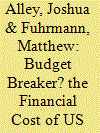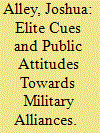| Srl | Item |
| 1 |
ID:
184242


|
|
|
|
|
| Summary/Abstract |
How do alliance commitments affect US military spending? This question is at the heart of debates about the value of alliances and the future of US grand strategy. One perspective, which we call the budget hawk view, asserts that alliances are exorbitantly expensive, as they require military investments to deter third-party adversaries and reassure allies, encourage free riding, and facilitate reckless allied behavior. A competing view, which we label the bargain hunter perspective, claims that US alliance commitments are relatively cheap and might even reduce military spending. Allies provide key military capabilities, reassurance and extended deterrence are cheaper than they might initially seem, and alliances reduce the need for costly military interventions by promoting peace. Despite the importance of this debate, few studies have attempted to determine how alliance commitments affect US military spending. We use over-time variation in the number of US alliance commitments to estimate their financial toll. A statistical model of US defense expenditures from 1947 to 2019 shows that one new alliance commitment has a large positive association with defense budget levels in subsequent years. Military alliances benefit the United States in many ways but, consistent with the budget hawk view, they are expensive.
|
|
|
|
|
|
|
|
|
|
|
|
|
|
|
|
| 2 |
ID:
193120


|
|
|
|
|
| Summary/Abstract |
Do elite cues exert extensive, conditional or minimal influence on public support for military alliances in the United States? I assess the boundaries of elite leadership on public opinion towards alliances by dividing partisan respondents into wings based on isolationism and militant assertiveness. If co-partisan elite cues change public attitudes across three or four wings within their party, elites exert extensive influence. Elite cues exert conditional influence if they reach two party wings, and minimal influence if they impact one or no wings. Using two conjoint survey experiments to examine public attitudes towards forming and maintaining international alliances, I find that elite cues exert extensive influence, but some individuals hold rigid alliance attitudes. Staunch alliance supporters in the Democratic party and consistent alliance skeptics in the Republican party both discount elite cues. Therefore, elites can lead most party wings with alliance cues, but intra-party divisions can constrain their influence.
|
|
|
|
|
|
|
|
|
|
|
|
|
|
|
|